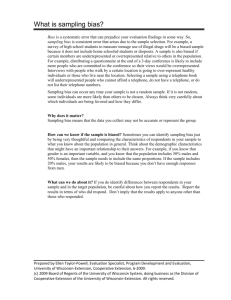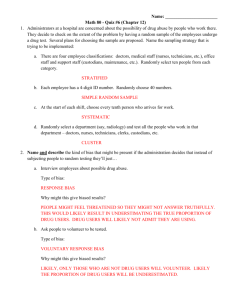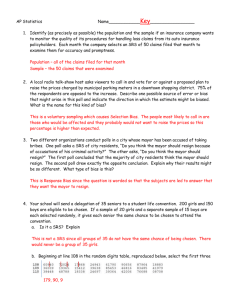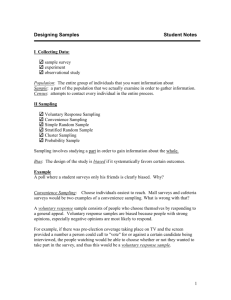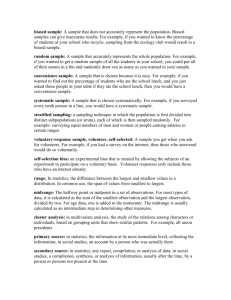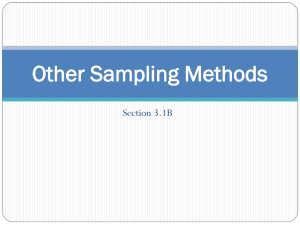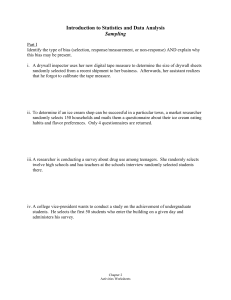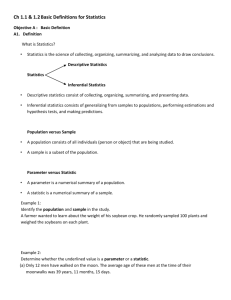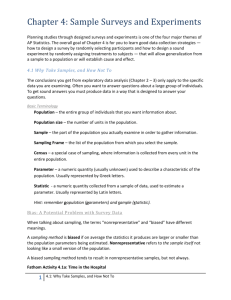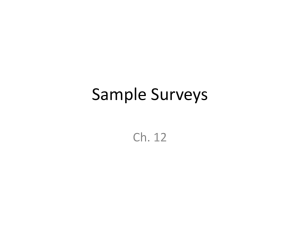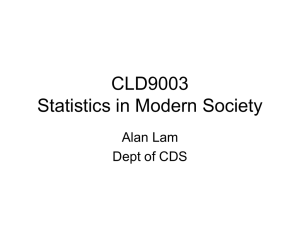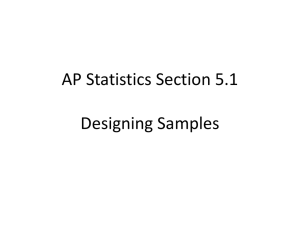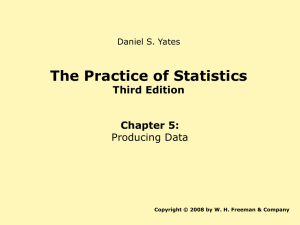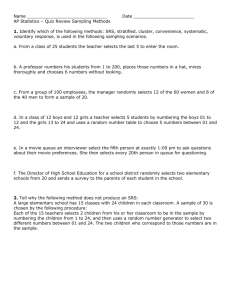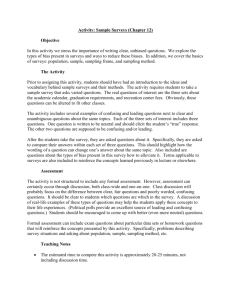File - Glorybeth Becker
advertisement
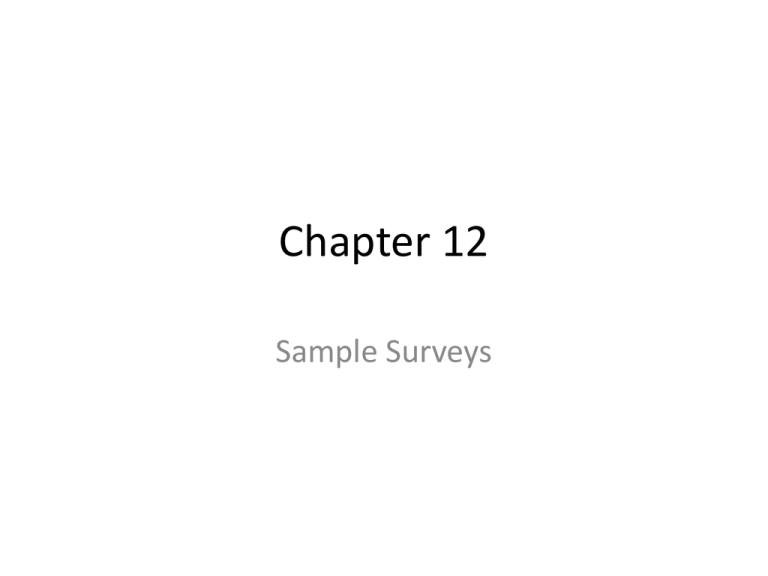
Chapter 12 Sample Surveys Activity: Should We Census or Not? Suppose I want to know how often, if ever, I can expect students to cheat on a math test. In order to answer this question, I will collect data using a survey. • To whom should I give the survey? • How should I select which students receive the survey? • What question(s) should I ask on the survey? • Should I have any concerns about the accuracy of their responses? Designing Samples: Suppose we want to gather information about a group of people. • If the group is small (for example, all students in this class) we can study each group member directly. This is called a census. • If, however, the group is very large (for example, all students in the school), studying each member of the group may not be feasible. As an alternative, we can select a smaller group of people who resemble the entire group. The entire group of individuals (not necessarily people) that we want information about is called the population. The part of the population in the study is called the sample. The list of individuals who actually had a chance to be included in the sample is called the sampling frame. How does the sampling frame differ from the population? The method we use to select the sample is called the sample design. The design of the sample is very important. If the design is poor, the sample will not accurately represent the population. In the example above regarding how often students cheat on a math test: • Identify the population • Identify the sampling frame • Identify the sample If the sample is not representative of the population, we say it is biased. Biased samples cannot be used to make reliable conclusions about a population. We therefore want to avoid bias as much as possible when sampling. One way to do so is to ensure that the sample is chosen randomly. Random samples that are sufficiently large are likely to be representative of the population. Because we sample without replacement, however, we must ensure that we don’t sample more than 10% of the population. If we have a representative sample, we can use the data from that sample to draw conclusions about the populations. Actual calculations based on data are called statistics, while theoretical values for a model are called parameters. Examples of statistics and their corresponding parameters: Examples of statistics and their corresponding parameters: Statistic Mean Standard Deviation Correlation Regression Coefficient Proportion Parameter Types of Sample Designs: Voluntary Response Sample • A large group of individuals are invited to respond, and those who do respond are included in the sample • Example: I could make a TV announcement asking for volunteers to stop by my classroom and pick up a survey, or I could ask advisors to pass out surveys and have students return them. • Problem: Those with strong (negative) opinions tend to volunteer. Those who volunteer may have something in common that sets them apart from those who do not volunteer. Therefore the sample is not representative of the population. Convenience Sample • Select individuals who are conveniently available. • Example: I could distribute the survey to students in my class. • Problem: Convenience samples are rarely representative of the population. Both Voluntary Response Samples and Convenience Samples result in samples that are not representative of the population. These are biased samples because they favor certain outcomes over others. Random selection eliminates bias from sample choice. Simple Random Sample (SRS) • Each individual is equally likely to be chosen for the sample, and each combination of individuals is equally likely to be chosen for the sample. • Example: Generate a list of student ID numbers for all students at WLHS; then randomly select student ID numbers and choose those students for the sample. Systematic Random Sample • Select every nth individual to be in the sample. • Example: Obtain a list of all students at WLHS. Choose every 5th person on the list. Stratified Random Sample • Divide the population into homogeneous groups (strata), then select a random sample from each group. • Example: Divide all of the students at WLHS into four homogeneous groups: freshmen, sophomores, juniors, and seniors; then choose a SRS from each grade level. Alternatively, I could divide all of the students at WLHS into two homogeneous groups: male and female, and then choose a SRS from each gender group. Cluster Sample • Divide the population into heterogeneous groups. Randomly select one or more groups and include all individuals from those groups in the sample. • Example: I could randomly choose one of the four lunch periods and survey ALL students having that lunch period. Multistage Sample • Combining several sampling methods. • Example: Select several departments within the school (Math, English, Art). Within each of those departments, select several teachers. Choose all students within each class. Although random selection eliminates bias from our choice of sample, it does not guarantee that our sample is representative of the population. Other potential problems include: Undercoverage: • Some part of the population has been left out of the process of choosing a sample. • Example: Students in ARL, early release, on suspension, or absent may be left out of the sample. Nonresponse: • Some individuals cannot be contacted or refuse to cooperate. • Example: A student chosen for the sample may refuse to divulge information or may be absent. Response Bias • Individuals may be dishonest or may answer a question untruthfully. • Example: Students may lie about cheating out of guilt or fear of being caught. Wording of Questions • Poorly worded questions can result in response bias if they are unclear or present only one side of an issue. Explain what is wrong with each of the following questions: • Example 1: “In a recent study, students in an Algebra I course were given a 25 question basic skills test. On average, students used a graphing calculator to answer 21 out of 25 questions. Do you think graphing calculators are overused?” Wording of Questions Explain what is wrong with each of the following questions: Example 2: “By using a graphing calculator, students in an Algebra I course are able to make visual connection between equations and their graphs, reinforcing difficult concepts. Do you think graphing calculators are overused?” Wording of Questions Explain what is wrong with each of the following questions: Example 3: “Do you like English or Math?” Example 4: “Do you like school?” Example 5: “Do you send/receive text messages frequently?” Example 6: “Do you believe posting anti-drug posters in schools is salubrious?”
